Legend of Soviet Aviation
In 1930, the profession of an aviator gained immense popularity in the world. The Soviet Union was no exception. The country developed rapidly in industrial terms, its military power grew, its scientific potential increased. Hundreds of thousands of Soviet boys and even girls dreamed about the sky, dreamed of flying. Heroes - pilots, fearlessly driving the machines that stormed the sky, caused a nationwide admiration. Respect for the conquerors of the sky grew as the Soviet press reported on more and more new exploits of pilots. The names of Valery Chkalov, Vladimir Kokkinaki, Mikhail Gromov and other pilots who made non-stop flights were on the lips of millions of Soviet citizens. “First of all airplanes, and girls later” - was sung in a popular Soviet song. But many Soviet girls of those years did not think so - and they themselves sat at the helm of the aircraft.
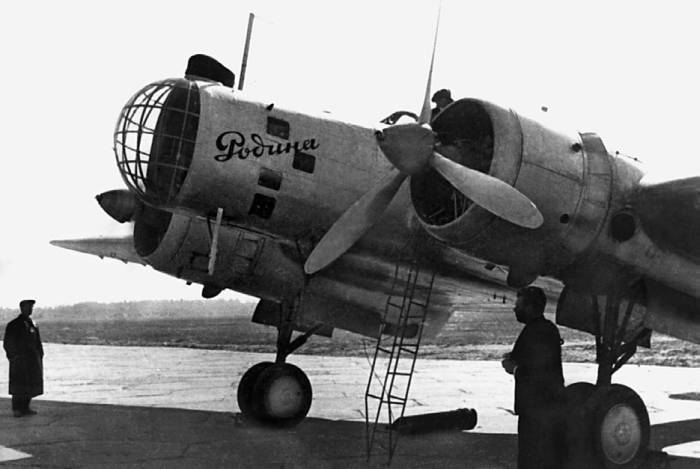
Thirties nonstop flights
Aviation The “find” of the thirties was non-stop flights - over as long distances as possible. In the mid 1930s The idea of organizing a non-stop flight from the Soviet Union to the United States of America was spread among Soviet pilots and the country's leadership. The first such flight was planned in August 1935. It was supposed to go along the route Moscow - North Pole - San Francisco. An AN-25 aircraft flew from Moscow under the command of Sigismund Levanevsky (1902-1937), which also included pilot Georgy Baidukov (1907-1994) and navigator Viktor Levchenko (1906-1937). Levanevsky, by the way, was one of the organizers and a direct participant in the rescue of passengers of the Chelyuskin steamer, for which he received the star of the Hero of the Soviet Union. But the flight through the North Pole due to aircraft malfunction did not occur. In 1936, pilot George Baidukov proposed a second attempt to fly without landing on land from the Soviet Union to the United States of America. Together with Chkalov and Belyakov, he applied for permission to Joseph Vissarionovich Stalin. But Stalin decided that after an unsuccessful attempt by the Levanevsky crew, the Soviet pilots should conduct a training flight first and offered to fly from Moscow to Petropavlovsk-Kamchatsky. July 20-22, 1936 the crew of the commander V.P. Chkalov, co-pilot G.F. Baidukov and navigator A.V. Belyakova made a non-stop flight from Moscow to the island of Udd. The crew was in the air for 56 hours and 20 minutes, after which it landed on the island of Udd at the mouth of the Amur River (later this island was named after the crew commander Valery Chkalov).
On June 18-20, 1937, the first non-stop flight of Soviet aviators from the USSR to the USA was completed along the route Moscow-North Pole-Vancouver. The crew of the ANT-25 was commanded by V.P. Chkalov, the co-pilot was G.F. Baydukov, and navigators - A.V. Belyakov. On July 12-14, 1937, a non-stop flight from Moscow through the North Pole to San Jacinto (California, USA) was performed by the ANT-25 crew under the command of M.M. Gromov, who also included the co-pilot Major A.B. Yumashev and 3rd-rank military engineer S.A. Danilin. However, in addition to flights to the United States, pilot flights without landing on land from the European part of the RSFSR to the Far East were even more important for the country. On June 27-28, 1938, the crew of TsKB-30 “Moscow” flew from Moscow to the Far East, which included pilot Vladimir Kokkinaki and navigator Alexander Bryandinsky. The flight distance of 7580 kilometers lasted 24 hours 36 minutes. Kokkinaki and Bryandinsky landed in Spassk-Dalsky, establishing the shortest air route from Moscow to the Pacific coast. For this flight, Vladimir Kokkinaki and Alexander Bryandinsky received the stars of Heroes of the Soviet Union. The feat of Kokkinaki and Bryandinsky literally three months later decided to repeat the women - aviators. In those years, the pilot profession was also popular among Soviet women, this is only after the end of World War II and due to the complexity of aviation technology, women will practically disappear from the air fleet.
Female flight from Moscow to the Far East
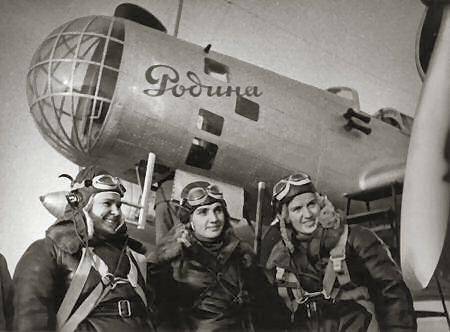 24 - 25 September 1938 Propulsion ANT - 37 "Motherland" plane flew from Moscow to the Far East. It consisted of three women. The team came up young in age but highly professional. The crew navigator was Marina Mikhailovna Raskova (1912-1943) - graduate of the Leningrad Institute of Engineers of the Civil Air Fleet, who a year earlier, in 1937, participated in setting the world distance record for the AIR-12 aircraft, and in 1938, set the 2 world distance record on the seaplane MP-1. The co-pilot was Polina Denisovna Osipenko (1907-1939). Despite her young years, Polina Govyaz (this was the name of Osipenko for her first husband) managed to work as a head of the poultry farm, and then chose aviation, graduated from the renowned Kachinsky school and became a pilot, then a flight commander in fighter aircraft. In 1938, under the command of Polina Osipenko, a non-stop flight was made from Sevastopol to Arkhangelsk. The crew was commanded by Valentina Stepanovna Grizodubova (1909-1993), a hereditary professional female pilot, who in October 1937 set five world aviation records on light aircraft.
24 - 25 September 1938 Propulsion ANT - 37 "Motherland" plane flew from Moscow to the Far East. It consisted of three women. The team came up young in age but highly professional. The crew navigator was Marina Mikhailovna Raskova (1912-1943) - graduate of the Leningrad Institute of Engineers of the Civil Air Fleet, who a year earlier, in 1937, participated in setting the world distance record for the AIR-12 aircraft, and in 1938, set the 2 world distance record on the seaplane MP-1. The co-pilot was Polina Denisovna Osipenko (1907-1939). Despite her young years, Polina Govyaz (this was the name of Osipenko for her first husband) managed to work as a head of the poultry farm, and then chose aviation, graduated from the renowned Kachinsky school and became a pilot, then a flight commander in fighter aircraft. In 1938, under the command of Polina Osipenko, a non-stop flight was made from Sevastopol to Arkhangelsk. The crew was commanded by Valentina Stepanovna Grizodubova (1909-1993), a hereditary professional female pilot, who in October 1937 set five world aviation records on light aircraft. When the plane passed the Ural Mountains, the connection with the ground was interrupted and for this reason the crew passed Komsomolsk-on-Amur. Above the coast of the Sea of Okhotsk, the crew saw that gasoline remained for half an hour of flight. It was decided to sit in the forest with the landing gear retracted. Grizodubova ordered the navigator Raskova to jump with a parachute, as an emergency landing could be a danger to the life of the navigator sitting in front. Marina Raskova, jumping with a parachute into the taiga, was found only ten days later. Alive - and this despite the fact that with her she had two bars of chocolate. Grizodubova and Osipenko planted a plane on a marsh in the upper reaches of the Amguni River. Meanwhile, the search began for the aircraft. Airplanes cruised from Baikal to the Sea of Okhotsk, while searches were conducted by teams from local residents. On October 3, a landed crew was found from the plane, after which the Far Eastern boat was sent from the village of Kerby to the crew’s rescue, which saved the women pilots. During the 26 hours of 29 minutes of direct flight, the crew of Grizodubova covered the distance of 6450 km. The world record for flight range for female aviators was blocked. Pilots with honor met all Soviet cities and towns, located on the way from Kirby to Moscow. Grizodubova, Osipenko and Raskova 2 November 1938 were awarded the high title of Heroes of the Soviet Union.
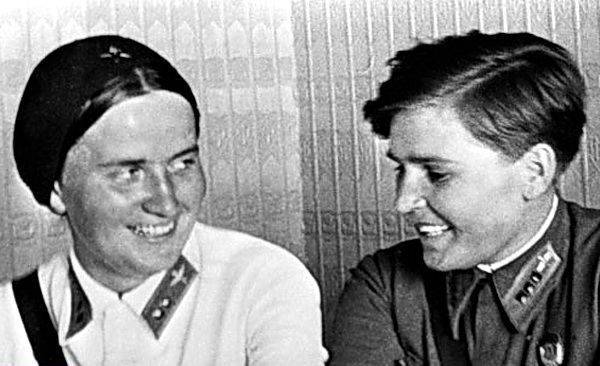
Marina Raskova and Polina Osipenko. 1938
Subsequently, the fate of the participants of the legendary flight took shape in different ways. Polina Denisovna Osipenko served as an inspector in aerobatic techniques, but 11 in May 1939 was killed in an aircraft crash during training camp, along with the head of the main flight inspection of the RKKA Air Force A.K. Serov. She was just 31 year. Marina Mikhailovna Raskova served in the Red Army Air Force, simultaneously listed in the states of the NKVD of the USSR. So from February 1937 to February 1939. she was a full-time consultant authorized by a special department, then she served in the 3 Office of the People's Commissariat of Defense of the USSR with the rank of senior lieutenant of state security. When the Great Patriotic War began, Marina Mikhailovna Raskova initiated the creation of separate female combat units. Since she was well known to Stalin as a participant in the legendary 1938 flight of the year, she managed to gain the favor of the Soviet leader and get "good" for the formation of women's aviation units. It was Marina Raskova who stood at the origins of the formation of the famous "Night Witches". She served as commander of the 587 Bombing Aviation Regiment (on Pe-2). 4 January 1943 Marina Raskova died in a plane crash near the village of Mikhaylovka, Saratov region, flying to the front from the redevelopment site. In memory of the brave aviator, the 587 th Bomber Aviation Regiment was renamed the 125 Guards Dive Bomber Aviation Regiment named after Marina Raskova of the Borisov Order of the Suvorov and Kutuzov Regiment. The sky claimed the lives of two of the three participants in the legendary flight. And only the heroine of our article, the crew commander of the legendary Valentina Grizodubova, managed not only to survive the terrible years of the Great Patriotic War, but also to live a very long and interesting life.
Hereditary pilot
Valentina Grizodubova was, as we said above, a hereditary aviator. Her father Stepan Vasilyevich Grizodubov (1884-1965) dedicated his life to aviation. He was not only a pilot, but also a designer — one of the first pilots and aircraft designers in Russia. Despite the noble origin (Stepan Vasilyevich was born in the family of the leader of the nobility of the Sumy county of the court councilor Vasily Mikhailovich Grizodubov), the father of the renowned pilots chose a technical work for himself. He was educated at the Kharkov Railway College, having mastered the specialty of electrical engineering. After that, he became the head of the power station of the nobility assembly of Kharkov, at the same time opening his own electric workshop.
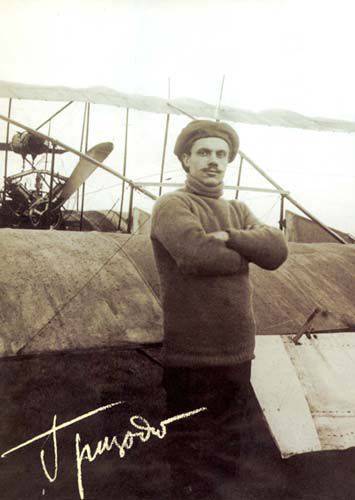 In 1908, a young engineer began designing and building an airplane based on a copy of the aircraft of the famous Wright brothers. But the plane, assembled in the absence of drawings, could not take off into the air. Nevertheless, the third plane of Stepan Grizodubov managed to take off in 1912 year. During the First World War, when Stepan Grizodubov was mobilized into the army, he managed to qualify as an aviator in the Petrograd Aviation School. After that, his whole life was connected with aviation and aircraft design. In 1919-1920 under the leadership of Stepan Grizodubov, the workshops of the Kharkov air fleet were operating, in which aircraft for the needs of the Red Army were restored. In 1924, the city of Grizodubov headed the section of glider sports and low-power aviation of Osoaviakhim of the Ukrainian SSR and Crimea. He taught the younger generations of Soviet military and civilian pilots, making an invaluable contribution to strengthening the defense capability of our country. In the right direction, Stepan Vasilyevich raised his daughter, Valentina.
In 1908, a young engineer began designing and building an airplane based on a copy of the aircraft of the famous Wright brothers. But the plane, assembled in the absence of drawings, could not take off into the air. Nevertheless, the third plane of Stepan Grizodubov managed to take off in 1912 year. During the First World War, when Stepan Grizodubov was mobilized into the army, he managed to qualify as an aviator in the Petrograd Aviation School. After that, his whole life was connected with aviation and aircraft design. In 1919-1920 under the leadership of Stepan Grizodubov, the workshops of the Kharkov air fleet were operating, in which aircraft for the needs of the Red Army were restored. In 1924, the city of Grizodubov headed the section of glider sports and low-power aviation of Osoaviakhim of the Ukrainian SSR and Crimea. He taught the younger generations of Soviet military and civilian pilots, making an invaluable contribution to strengthening the defense capability of our country. In the right direction, Stepan Vasilyevich raised his daughter, Valentina.Valentina Stepanova Grizodubova was born on 27 on April 1909 in Kharkov. The way to the sky for Vali Grizodubova began almost from birth. Already at the age of two, Valentina was taken by father with him on an airplane flight, tied with straps. In her teens, Valentina had already been successful in the glider club, having completed her first glider flight at 14 for years - during the rally of glider pilots in Koktebel. However, in his youth, aviation remained only a hobby. However, Valentina chose the engineering profession - she entered the Kharkov Institute of Technology. At the same time, the girl also demonstrated her very unexpected skills for the hereditary pilots - she graduated from the music school, having learned to play the piano, and entered the conservatory.
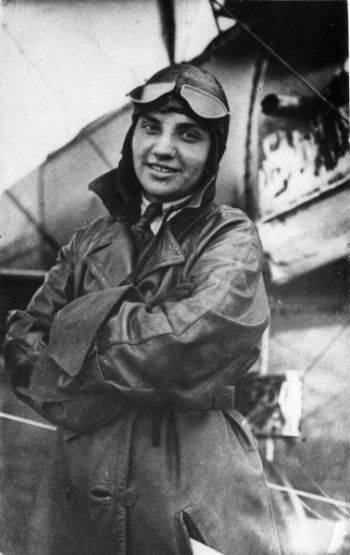 Valentina Grizodubova’s serious aviation career began in 1928, when she was only 19 years old. 4 November 1928, she entered the Kharkov Central Aero Club and was able to accelerate at the accelerated pace for three months, after which she went to the 1-th Tula Osoaviahima flight school. In 1929, we see it already in the Penza school of instructor pilots. From 1930 to 1933, after receiving flight training, Valentina Grizodubova herself became an instructor pilot. She worked at the Dobrolet flying club in Tula, at the flight school in Tushino. In those years, there were so-called agitation squadrons, which were used to modernize the propaganda work of the party and Komsomol organs. In 1934-1935 Valentina Grizodubova served just in such a squadron - the agitation squadron named after Maxim Gorky, which was stationed at the Central Aerodrome of Moscow. Recall that the squadron them. Maxim Gorky was created as a result of a fundraiser, launched in October of 1932 by Ogonek magazine. The chief editor of the journal, Mikhail Koltsov, also became part-time squadron commander. 17 March 1933 Head of the General Directorate of the Civil Air Fleet of the USSR Council of People’s Commissars A.Z. Holtzman signed the order on the formation of the agitation squadron named after Maxim Gorky. The squadron departures began the same year - 5 in May 1933 in. Valentina Grizodubova flew the Rabbit Woman and Hero of the Soviet Union aircraft. In the propaganda squadron, Grizodubova circled the entire Soviet Union, including such remote areas as the Pamir Mountains and the Fergana Valley.
Valentina Grizodubova’s serious aviation career began in 1928, when she was only 19 years old. 4 November 1928, she entered the Kharkov Central Aero Club and was able to accelerate at the accelerated pace for three months, after which she went to the 1-th Tula Osoaviahima flight school. In 1929, we see it already in the Penza school of instructor pilots. From 1930 to 1933, after receiving flight training, Valentina Grizodubova herself became an instructor pilot. She worked at the Dobrolet flying club in Tula, at the flight school in Tushino. In those years, there were so-called agitation squadrons, which were used to modernize the propaganda work of the party and Komsomol organs. In 1934-1935 Valentina Grizodubova served just in such a squadron - the agitation squadron named after Maxim Gorky, which was stationed at the Central Aerodrome of Moscow. Recall that the squadron them. Maxim Gorky was created as a result of a fundraiser, launched in October of 1932 by Ogonek magazine. The chief editor of the journal, Mikhail Koltsov, also became part-time squadron commander. 17 March 1933 Head of the General Directorate of the Civil Air Fleet of the USSR Council of People’s Commissars A.Z. Holtzman signed the order on the formation of the agitation squadron named after Maxim Gorky. The squadron departures began the same year - 5 in May 1933 in. Valentina Grizodubova flew the Rabbit Woman and Hero of the Soviet Union aircraft. In the propaganda squadron, Grizodubova circled the entire Soviet Union, including such remote areas as the Pamir Mountains and the Fergana Valley. In October, 1937 of Grizodubova set five world aviation records on light aircraft. So, October 7 1937 G.V. Grizodubova set a record for speed of flight on 100-km closed route - 218,18 km / h. Two days later - October 9 1937 - Valentina Grizodubova set two records at once - in flight speed on 100-km. closed route: 190,88 km / h independently on a UT-1 seaplane, and 200 km / h along with flight engineer S. Slobozhenko on a UT-2 seaplane. 15 October 1937 was set a record for flight altitude on the UT-2 - 3267 m. (Also in the crew with flight mechanic E. Slobozhenko). Finally, on October 24 1937, on the AIR-12 plane, pilot Valentina Grizodubova and navigator Marina Raskova set a straight-line distance record - 1444, 72 km.
In 1938, Mr. Grizodubova was given the high honor of leading a non-stop flight of a female crew from Moscow to the Far East. After the flight, Valentina received the title of Hero of the Soviet Union, as well as other women from her crew. Participation in the flight was the beginning of her big air career. In 1939, thirty-year-old Valentina Grizodubova was appointed head of the Directorate for International Airlines of the USSR. In this position she not only was engaged in professional activities, but also did a lot of good to people who suffered from illegal repressions. So, Grizodubova was one of those people who stood up for Sergei Korolev. Thanks to the requests of Grizodubova and pilot Mikhail Gromov, Korolev was transferred from the camp to the Central Design Bureau No. 29. In 1940-1941 Grizodubova, simultaneously with the leading activity in the Directorate of international airlines, she studied at the Academy of Civil Air Fleet of the USSR.
Since the beginning of World War II, Valentina Grizodubova, like many other female pilots, decided to go to the front. And this is despite the fact that she headed the Anti-Fascist Committee of Soviet Women, was a deputy to the Supreme Soviet of the USSR. Many Soviet pilots were asked to join the Red Army Air Force combat units. Marina Raskova, who served in the crew of Grizodubovaya navigator, led the famous Night Witches regiment - the 587-th bomber aviation regiment.
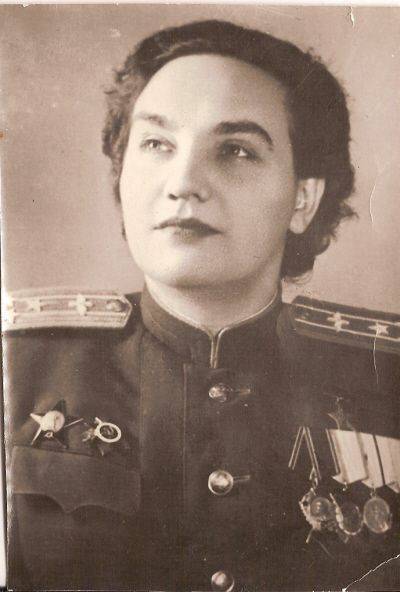 From June 1941, from the first days of the war, until the spring of 1942, Valentina Grizodubova was in charge of the ship of the Moscow Special Purpose Aviation Group of the USSR Civil Air Fleet. In spite of the fact that the group was organizationally related to civil aviation, it had to solve combat missions - after all, the military transport aviation of the USSR was created essentially on the basis of a civil air fleet. Civilian aircraft and yesterday's civilian pilots had to deliver people and cargo to the front line, to solve the problem of providing troops and partisan detachments from the air.
From June 1941, from the first days of the war, until the spring of 1942, Valentina Grizodubova was in charge of the ship of the Moscow Special Purpose Aviation Group of the USSR Civil Air Fleet. In spite of the fact that the group was organizationally related to civil aviation, it had to solve combat missions - after all, the military transport aviation of the USSR was created essentially on the basis of a civil air fleet. Civilian aircraft and yesterday's civilian pilots had to deliver people and cargo to the front line, to solve the problem of providing troops and partisan detachments from the air. 101 long-range aviation regiment
In March, 1942, Hero of the Soviet Union, Lieutenant Colonel of Aviation Valentina Grizodubova was appointed commander of the 101 th aviation regiment of long-range aviation. 15 April 1942 began the formation of a regiment, which became part of the 1-th Long-Range Aviation Transport Division and was called the 101-Long Range Aviation Regiment for the first months. At the Moscow-based Chkalovsky airfield, the regiment was formed by taking the Moscow Special Purpose Group as the core of personnel. The commanding staff of the regiment arrived from the 1 th long-range aviation regiment, and the personnel came from the long-range aviation reserve stationed in the city of Buzuluk. Until 25 in May 1942, the formation of the regiment continued at an accelerated pace and the preparation of the flight personnel for the coming sorties. The regiment was equipped with aircraft Li-2. The number of aircraft by the fall of 1942 was brought to 30.
25 May 1942 was made the first combat departure of the regiment. From the Urazovo airfield, cargo was delivered to parts of the Red Army fighting in the Balakliya region of the Kharkiv region. In June, a part of the regiment's airplanes 1942 was assigned to the operational group of transport aviation to support the 2 th Attack Army. More than a hundred sorties made the regiment's pilots without a loss of aircraft and personnel, delivering ammunition and food to the units of the 2 Shock Army. Gradually the regiment increased bomber orientation. So, from June 25 to August 19, the 1942 regiment bombed enemy communications — the Kursk, Oryol, Vyazma railway junctions, etc. During these months, the regiment pilots made 376 sorties and dropped 457,5 tons of bombs. Every night there were at least two sorties. On the night of 28 on July 1942, the regiment made the first mass sortie to the partisan units operating in Belarus. 11 August 1942 was made the first landing at the partisan airfield - crew Chernopyatova landed in the area Saltanovki. From July 28 to August 18, 17 was flown to guerrilla sites.
22 August The 1942 regiment was redeployed to the Stalingrad area and deployed at the operational airfield in Balashov. During this period, the crews of the regiment began to depart in order to bombard the ferry across the r. Don and r. Wormhole, as well as enemy trains on the railway tracks. The entire crews of the regiment from 22 August to 15 September 1942 made 401 combat sortie, dropping 413 tons of aerial bombs. The command of the Stalingrad Front twice thanked the personnel of the 101 Aviation Regiment. 15 September The 1942 regiment was redeployed from the Stalingrad area to the central headquarters of the partisan movement. Between September 16 and December 31 1942, the regiment planes made 404 departures, including 33 departures, landing on partisan airfields.
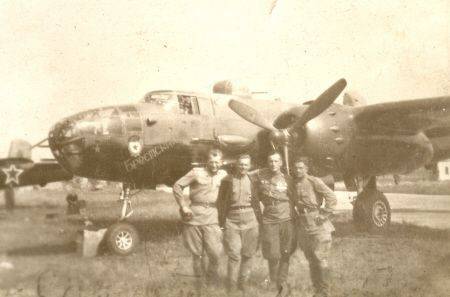 The regiment acted in order to ensure the Belarusian, Ukrainian, Kalininsky, Bryansk, Western headquarters of the partisan movement. On October 1, 5 flew one night 25 sorties to discharge cargo at the partisan site in Smiliz. At the same time, returning from the partisans, the regiment airplanes carried out the tasks of aerial bombardment of enemy objects and punitive divisions. In December 1942, part of the regiment operated from the operational airfield Migalovo, providing the Kalinin Front, from 24 December 1942 to 19 in January, 1943, the regiment provided for the delivery of ammunition, fuel and removal of the wounded of the South-Western Front. January 27 to October 2 1943 the regiment was based in Monino of the Moscow region. The regiment's pilots continued to make combat missions to ensure guerrilla units and detachments operating in the rear of the enemy. Providing guerrillas with ammunition and food becomes during this period the main direction of the combat activity of the regiment. From 15 in October 1942 to 15 in September 1943 1862 was committed to night departures, including 300 - with landing on partisan airfields in the rear of the enemy. 1371 tons of goods were delivered, 103 tons of food, 1519 people. Aircraft regiment evacuated 3105 wounded partisans, children, 52 pilot shot down over the territory occupied by the enemy, the crews of aircraft. At the same time, the regiment solved the tasks of bombing the enemy troops on the railway tracks. More than 370 departures were made for the bombardment of moving trains, 79 departures - for the bombing of the airfields used by the enemy. In August and September, the 1943 g. Regiment bombarded Hitler's troops in the Smolensk-Bryansk sector, making 275 combat missions. The September 25 regiment ensured that the Dnieper landing operation was carried out by making the 33 departure and parachuting the 582 man. October 15 1943. The 101 th Long-Range Aviation Regiment received the Red Banner in accordance with the Decree of the Presidium of the USSR Supreme Soviet.
The regiment acted in order to ensure the Belarusian, Ukrainian, Kalininsky, Bryansk, Western headquarters of the partisan movement. On October 1, 5 flew one night 25 sorties to discharge cargo at the partisan site in Smiliz. At the same time, returning from the partisans, the regiment airplanes carried out the tasks of aerial bombardment of enemy objects and punitive divisions. In December 1942, part of the regiment operated from the operational airfield Migalovo, providing the Kalinin Front, from 24 December 1942 to 19 in January, 1943, the regiment provided for the delivery of ammunition, fuel and removal of the wounded of the South-Western Front. January 27 to October 2 1943 the regiment was based in Monino of the Moscow region. The regiment's pilots continued to make combat missions to ensure guerrilla units and detachments operating in the rear of the enemy. Providing guerrillas with ammunition and food becomes during this period the main direction of the combat activity of the regiment. From 15 in October 1942 to 15 in September 1943 1862 was committed to night departures, including 300 - with landing on partisan airfields in the rear of the enemy. 1371 tons of goods were delivered, 103 tons of food, 1519 people. Aircraft regiment evacuated 3105 wounded partisans, children, 52 pilot shot down over the territory occupied by the enemy, the crews of aircraft. At the same time, the regiment solved the tasks of bombing the enemy troops on the railway tracks. More than 370 departures were made for the bombardment of moving trains, 79 departures - for the bombing of the airfields used by the enemy. In August and September, the 1943 g. Regiment bombarded Hitler's troops in the Smolensk-Bryansk sector, making 275 combat missions. The September 25 regiment ensured that the Dnieper landing operation was carried out by making the 33 departure and parachuting the 582 man. October 15 1943. The 101 th Long-Range Aviation Regiment received the Red Banner in accordance with the Decree of the Presidium of the USSR Supreme Soviet. December 1943 - January 1944 The 101 air regiment decided the tasks of liquidating the blockade of the city of Leningrad. Also in early January, the 1944 regiment flew 70 combat missions to Malaya Zemlya - a bridgehead in the Oranienbaum area. 132 of the Red Army officer was transported here, 98 artillery pieces and 20,2 tons of combat cargoes were delivered. Simultaneously with the transport tasks, the regiment also solved the tasks of bombarding enemy troops concentrated in the vicinity of Leningrad. In February, the 1944 g. Regiment flew on missions to bombard military-industrial facilities in Finland. As you know, Finland was an ally of Hitler's Germany and participated in the blockade of Leningrad. 27 February for one night the regiment produced 62 departure, dropping a large number of aerial bombs on the industrial facilities of Helsinki. In many ways, it was the actions of the Soviet aviation, including the 101 regiment, that contributed to Finland’s rejection of its aggressive plans and its surrender.
Complaint against Marshal Golovanov
Valentina Grizodubova, who had commanded the 101 Aviation Regiment during the first years of the war, was given the military rank of colonel in 1943. Nevertheless, Valentina Stepanovna had a conflict with the higher command.
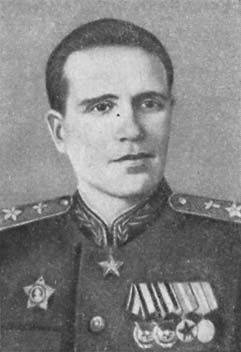 Air Marshal Alexander Golovanov, who served as commander of long-range aviation, claimed that the regiment under the command of Grizodubova was not distinguished by high discipline of personnel, for which he repeatedly made comments to her. In 1944, Mr. Grizodubova filed a complaint against Marshal Golovanov in the Central Committee of the CPSU (B.). If you take as a basis the memories of Marshal of Aviation Golovanov, then Grizodubova filed a complaint, seeking to obtain the rank of general. Obviously, ambitions have done their job, and despite the real flight and combat merits, the celebrated female pilot went on a not very correct path, deciding to complain about the superior commander, and even to the Central Committee of the party.
Air Marshal Alexander Golovanov, who served as commander of long-range aviation, claimed that the regiment under the command of Grizodubova was not distinguished by high discipline of personnel, for which he repeatedly made comments to her. In 1944, Mr. Grizodubova filed a complaint against Marshal Golovanov in the Central Committee of the CPSU (B.). If you take as a basis the memories of Marshal of Aviation Golovanov, then Grizodubova filed a complaint, seeking to obtain the rank of general. Obviously, ambitions have done their job, and despite the real flight and combat merits, the celebrated female pilot went on a not very correct path, deciding to complain about the superior commander, and even to the Central Committee of the party. Chief Air Marshal Alexander Golovanov in his memoirs writes: “The next day I was summoned to the Central Committee. Being absolutely sure that there is nothing reprehensible behind me, I somehow did not even think about who could write about me. When he came to the office of the secretary of the Central Committee, to his surprise he saw the regimental commander V. S. Grizodubov there. After greeting, I sat down. I was asked a significant number of questions, many of which I could not answer. Among such questions were, for example, the following: why is the regiment commanded by Grizodubov still not guards, while the other, organized at the same time, has already received a guards banner? Why did the regiment commander receive few awards? Why is Grizodubova still a colonel, while she is the only female commander in ADD, and why is her regiment in the position of her stepson? Why is the command bad for him? "(Golovanov AE Long-Range Bomber ... - M .: Delta NB LLC, 2004.). Meanwhile, the discipline in the regiment of Grizodubova, as already noted above, was low. Golovanov notes that Grizodubova herself repeatedly abandoned the regiment to the mercy of fate and left for Moscow, leaving the command of the regiment of her deputy major Zapylenov. This information during the investigation of the complaint of Grizodubova to the Central Committee of the CPSU (b) was reported by the corps commander, General V.E. Nestertsev and division commander, General V.I. Kartakov - direct commanders VS Grizodubova. The investigation revealed that the information reported by Grizodubova, who accused the commanders of long-range aviation in allegedly not recognizing her merits and “slowing down” the process of obtaining a general's rank and being appointed to the position of division commander, is not based on real reasons and is defamatory.
According to A.E. Golovanov, in his memoirs, the party commission under the leadership of the secretary of the Central Committee of the CPSU (b) G. Malenkov, decided to refer the matter to a military tribunal, but the air marshal himself, not wanting to act as a victim, refused claims to Grizodubova. The reason for the conflict that has developed is likely to be that, as a non-military man, Valentina Stepanovna Grizodubova did not quite understand the essence of military discipline, and ambition turned her head and she wanted to see herself as the first woman - general. One can hardly doubt the sincerity of the words of Marshal of Aviation Golovanov, who did not have any reason to deliberately belittle the merits of the celebrated female pilots, moreover, so obvious. But one thing is personal courage, the ability for such extreme actions as making a non-stop flight, and quite another is command of large aviation units and formations, which requires not only courage and bravery, but also leadership skills, organizational skills, and military service experience.
After the completion of the investigation in the Central Committee of the CPSU (b), Valentina Stepanovna Grizodubova was removed from the post of commander of the 101-th aviation regiment. The commander of the regiment was her deputy, Major Stepan Zapylenov, who soon received the rank of lieutenant colonel in aviation. Valentina Grizodubova herself was withdrawn from the personnel of long-range aviation. The regiment was converted to 31-th Guards Bomber. Tribute should be paid to the nobility of the Marshal of Aviation Golovanov - he did not give further progress on the case of Valentina Grizodubova’s complaint, although on the other hand the party leadership was not interested in the ostentatious punishment of the celebrated female pilot, Hero of the Soviet Union, even if he had made certain life mistakes. Therefore, according to the results of the war, Valentina Stepanovna was awarded the Order of the Patriotic War, I Degree. However, the annoying incident with Marshal Golovanov does not in the least detract from the military and labor merit of Valentina Stepanovna Grizodubova - her name is forever inscribed in gold letters in history Soviet military and civil aviation, the history of the Great Patriotic War.
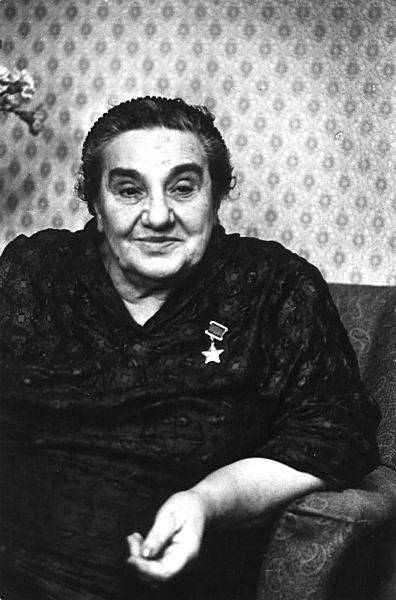
Post-war life. Memory of Valentina Stepanovna
In 1946, Colonel Aviation Valentina Stepanovna Grizodubova was dismissed. The brilliant military career of Valentina Grizodubova ended, and did not bring her generals epaulettes. Grizodubova returned to civil aviation. She was appointed deputy head of the 17 th Scientific Research Institute (Institute of Potential Engineering) for the flight unit. The tasks of the Grizodubova unit included tests of electronic equipment for the Air Force and civil aviation. Grizodubova participated in test flights, during which the radar equipment being developed at a research institute was tested.
In 1963, Valentina Grizodubova headed the Research and Flight Test Center at Solntsevo Airfield, which she managed for almost ten years - until 1972. At 1972, Valentina Stepanovna returned to the Institute of Instrument Engineering as a deputy head of the flight unit, where She worked until her death in 1993. 28 April 1993. Hero of the Soviet Union Valentina Stepanovna Grizodubova died at the 84-th year of life. She was buried in Moscow, at the Novodevichy cemetery. In September, an obelisk was erected in honor of the feats of Soviet pilots, in the form of a granite wing directed into the sky, in honor of the Moscow-Far East flight on the Okocha hill, not far from the Amgun River. In memory of Valentine Grizodubova 1973 September 1, a monument was erected at the entrance to the Research Institute of Instrument Making in Moscow. Since 2000, the Grizodubova Museum has been operating at the Moscow School No. 2001. In the name of Valentina Grizodubova, the streets are named in a number of cities in the former Soviet Union, including Moscow, Vladivostok, Yekaterinburg, Kurgan, Novosibirsk, Rostov-on-Don, and many other cities. Also, the name of Grizodubova was named JSC Flight Test and Production in Zhukovsky. Before 918, the 2009 Guards Krasnoselsky Red Banner Military Transport Aviation Regiment, which was named after Valentina Grizodubova, was part of the Russian Air Force. After the regiment was disbanded in October 103, the regiment banner was transferred to the air base in Orenburg.
(Photographic materials were used: http://101aviapolk.ru/, http://portal-kultura.ru/).
Information